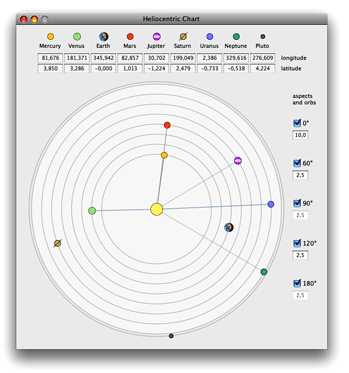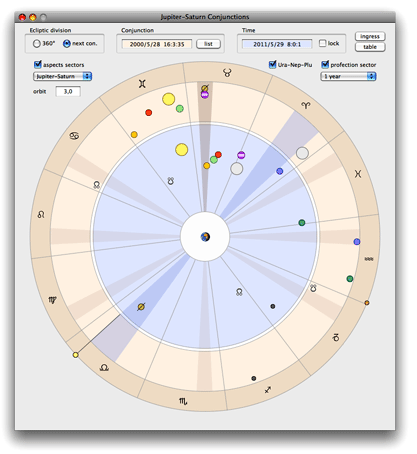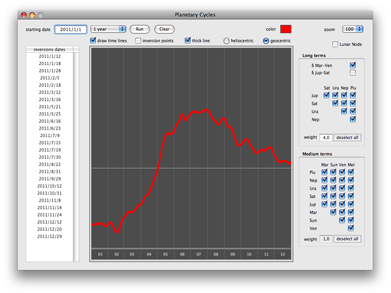| The Universal version includes all features of Professional plus three specific modules for universal or mundane astrology. |
|
 Heliocentric coordinates of planets Heliocentric coordinates of planets
This module calculates the heliocentric coordinates of planets, with conjunctions and aspects (sextile, square, trine, opposition) within user-defined orbs. The heliocentric coordinates are considered important by some authors, especially for mundane predictions. The Sun is at the center, followed by the orbits of Mercury, Venus, Earth, Mars, Jupiter, Saturn, Uranus, Neptune and Pluto. The coordinates are calculated according the VSOP87 theory of secular variations developed by the Bureau des Longitudes in Paris. Pluto is calculated for dates between 1601 and 2198. The same figure is also available for geocentric coordinates, in which case the Earth is at the center followed by the Moon’s orbit, and the Sun takes the place of the Earth. |
|
 Solar ingresses and Jupiter-Saturn conjunctions Solar ingresses and Jupiter-Saturn conjunctions
The doctrines of solar ingresses on the equinoctial and solstitial points and the conjunctions of outer planets, especially Jupiter-Saturn, are of great importance in mundane predictions. This bi-wheel chart compares the solar ingress (or any other chart) with the preceding Jupiter-Saturn conjunction. The period between two conjunctions is divided into "progression sectors" of the conjunction-degree, and the planetary positions of solar ingresses can be evaluated in reference to these sectors.
|
|
 Planetary Cycles Planetary Cycles
In 1948 Donald Bradley developed a complex method for the evaluation of celestial influence, considering the mutual configurations of planets. This method, known as "Siderograph" or "Planetary barometer", had great success in finance because the dates of inversion of the Siderograph line are reputed an index of changes in the general market “sentiment”, and consequently in stock market trends. The Planetary Cycles module, as well as to faithfully reproduce Bradley’s calculation, does much more: the user can select periods from 6 months to 20 years, isolate individual elements generating the curve, change the "weight" of these elements, include heliocentric longitudes, lunar node and Jupiter and Saturn declinations. |
